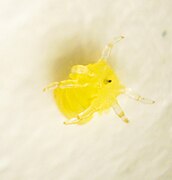
Hemiptera is an order of insects, commonly called true bugs, comprising over 80,000 species within groups such as the cicadas, aphids, planthoppers, leafhoppers, assassin bugs, bed bugs, and shield bugs. They range in size from 1 mm (0.04 in) to around 15 cm (6 in), and share a common arrangement of piercing-sucking mouthparts. The name "true bugs" is often limited to the suborder Heteroptera.

Galls or cecidia are a kind of swelling growth on the external tissues of plants, fungi, or animals. Plant galls are abnormal outgrowths of plant tissues, similar to benign tumors or warts in animals. They can be caused by various parasites, from viruses, fungi and bacteria, to other plants, insects and mites. Plant galls are often highly organized structures so that the cause of the gall can often be determined without the actual agent being identified. This applies particularly to some insect and mite plant galls. The study of plant galls is known as cecidology.

Celtis is a genus of about 60–70 species of deciduous trees, commonly known as hackberries or nettle trees, widespread in warm temperate regions of the Northern Hemisphere. The genus is part of the extended hemp family (Cannabaceae).

Psyllidae, the jumping plant lice or psyllids, are a family of small plant-feeding insects that tend to be very host-specific, i.e. each plant-louse species only feeds on one plant species (monophagous) or feeds on a few closely related plants (oligophagous). Together with aphids, phylloxerans, scale insects and whiteflies, they form the group called Sternorrhyncha, which is considered to be the most "primitive" group within the true bugs (Hemiptera). They have traditionally been considered a single family, Psyllidae, but recent classifications divide the group into a total of seven families; the present restricted definition still includes more than 70 genera in the Psyllidae. Psyllid fossils have been found from the Early Permian before the flowering plants evolved. The explosive diversification of the flowering plants in the Cretaceous was paralleled by a massive diversification of associated insects, and many of the morphological and metabolic characters that the flowering plants exhibit may have evolved as defenses against herbivorous insects.

The bell miner, commonly known as the bellbird, is a colonial honeyeater, endemic to southeastern Australia. The common name refers to their bell-like call. 'Miner' is an old alternative spelling of 'myna', and is shared with other members of the genus Manorina. The birds feed almost exclusively on the dome-like coverings, referred to as 'bell lerps', of certain psyllid bugs that feed on eucalyptus sap from the leaves. The psyllids make these bell lerps from their own honeydew secretions in order to protect themselves from predators and the environment.

Gall wasps, also incorrectly called gallflies, are hymenopterans of the family Cynipidae in the wasp superfamily Cynipoidea. Their common name comes from the galls they induce on plants for larval development. About 1,300 species of this generally very small creature (1–8 mm) are known worldwide, with about 360 species of 36 different genera in Europe and some 800 species in North America.

Aprostocetus is a genus of hymenopteran insects of the family Eulophidae. The genus was erected by John O. Westwood in 1833. This very large group of parasitoid wasps has a global distribution.
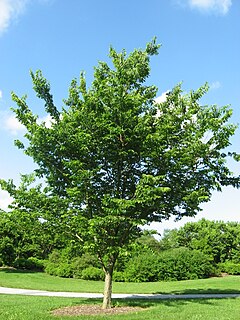
Celtis occidentalis, commonly known as the common hackberry, is a large deciduous tree native to North America. It is also known as the nettletree, sugarberry, beaverwood, northern hackberry, and American hackberry. It is a moderately long-lived hardwood with a light-colored wood, yellowish gray to light brown with yellow streaks.
"Candidatus Carsonella ruddii" is an obligate endosymbiotic Gammaproteobacterium with one of the smallest genomes of any characterised bacteria.

Centropyge venusta, the purplemask angelfish is a species of marine ray-finned fish, a marine angelfish belonging to the family Pomacanthidae, It is found in the Western Pacific and is occasionally found the aquarium trade.
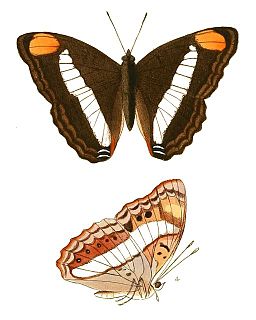
Doxocopa pavon, the Pavon emperor or Pavon, is a species of butterfly in the family Nymphalidae. They can be found from Paraguay in South America up to Texas in the southern United States. They are generally brown in their overall coloration, with two bands of white straddling the middle of the upper surfaces of the wings, and a patch of orange on the tips of their forewings. The upper surfaces of the wings of the males are overlaid by an iridescent blue-purple sheen. The females of the species closely resemble members of the unrelated genus Adelpha.

Euura is a genus of sawflies of the family Tenthredinidae, subfamily Nematinae. Some of the larvae feed externally on plants and some form plant galls on willows (Salix species). In the case of the gall-forming species, when the female lays her eggs she injects a stimulant and the gall start to form before the eggs hatch. Most sawfly galls are hard and individual larva tend to inhabit the gall, feeding on the tissue and leave the gall to pupate in the soil. Most of the species are monophages although the type species, Euura mucronata, is polyphagous feeding on over thirty species of willow.

Ampelomyia viticola, the grape tube gallmaker, is a species of gall midge found in the eastern United States and Canada. It produces green or bright red galls on new world grape vines.
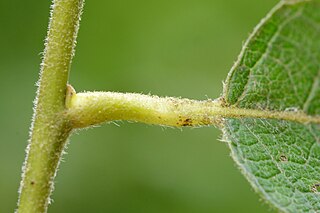
Euura venusta is a species of sawfly belonging to the family Tenthredinidae. The larvae feed within the leaf-stalk of willows forming a gall. The sawfly was first described by Carl Gustav Alexander Brischke in 1883.

Celticecis is a genus of hackberry gall midges in the family Cecidomyiidae.
Torymus pachypsyllae is a species of Torymid wasp found in North America. It primarily attacks the psyllid Pachypsylla celtidismamma, although it is known to attack other related species in the genus Pachypsylla.
Pachypsylla celtidisvesicula, commonly called the hackberry blistergall psyllid, is a species of aphalarid psyllid found in North America. The nymphs of this species induce blister-like galls on the leaves of various hackberries throughout its range.
Trioza eugeniae or the syzygium leaf psyllid, lillypilly psyllid, and eugenia psyllid is a sap-sucking hemipteran bug in the family Triozidae which creates galls on the leaves of Syzygium paniculatum. This species is native to Australia and has been introduced into California.
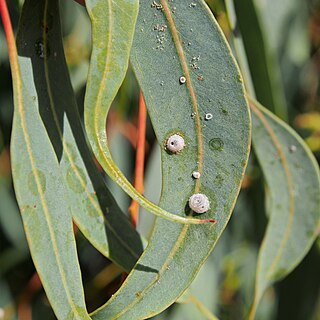
Glycaspis is a genus of plant-parasitic hemipterans in the family Aphalaridae. There are at least two described species in Glycaspis.
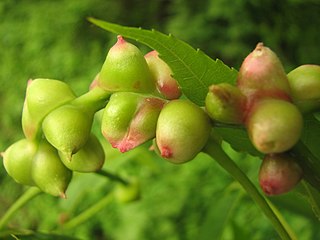
Phylloxera is a genus of true bugs belonging to the family Phylloxeridae.

